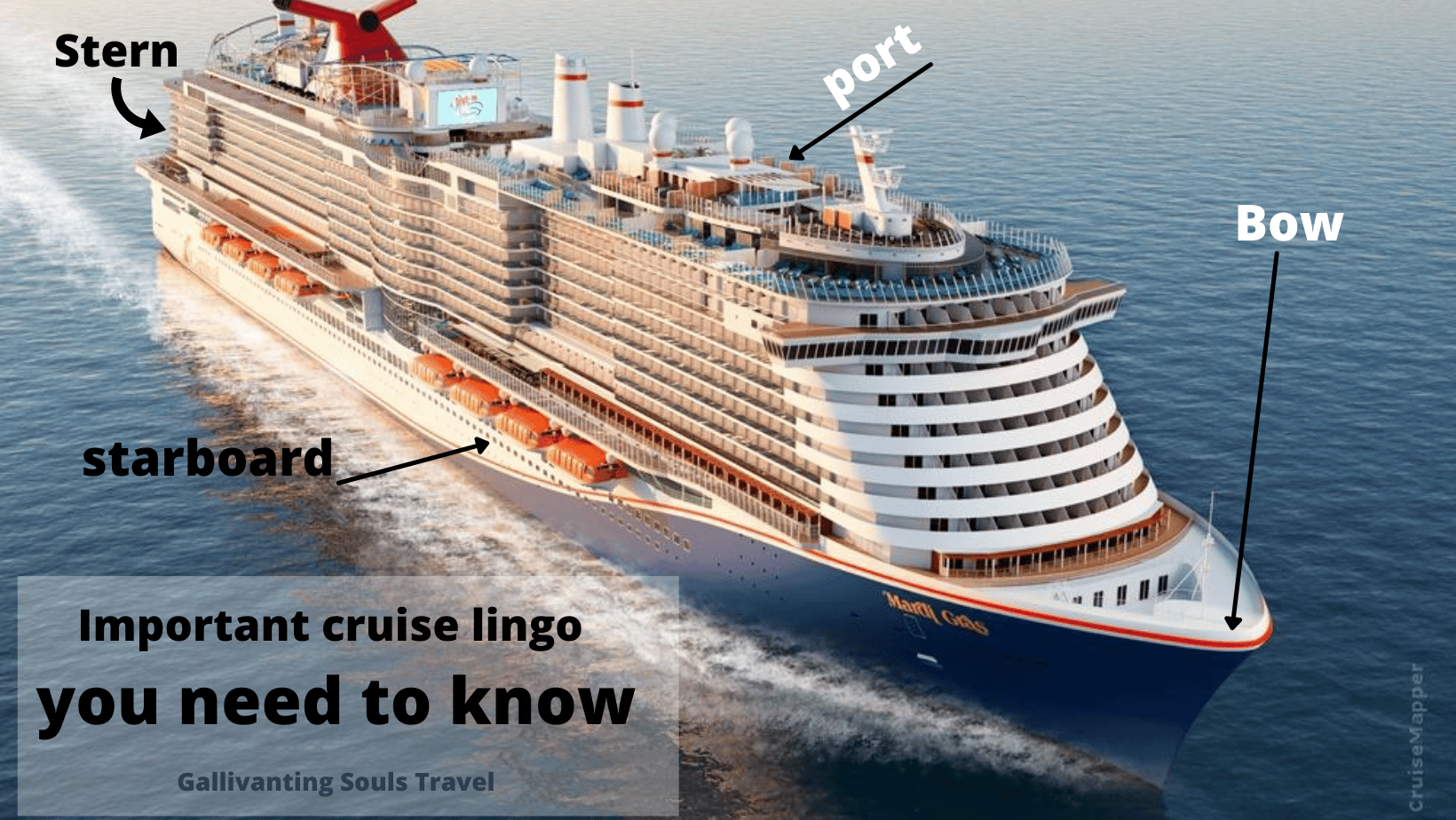Cruise lingo can be confusing for new cruisers, but don’t worry! This guide will help you understand the most important words and phrases used on a cruise, including some that will make you smile.
Introduction to cruise lingo
Cruising offers a unique experience that combines luxury, adventure, and relaxation. Whether you’re on a quick weekend getaway or a months-long world cruise, learning cruise ship lingo will make your trip more enjoyable and help you navigate the ship with ease.
Cruise Booking and Embarkation Phrases
Port of Embarkation: The home port from which your cruise ship leaves. It is essential to know the specific embarkation port and its location, as well as any transportation arrangements required to reach it.
Embark/embarkation: Embark (verb) or embarkation (noun) means to board a ship or airplane. In the context of cruising, it refers to the process of passengers boarding a cruise ship to begin their vacation.
Debark (verb) or debarkation (noun) means to disembark from a ship or airplane. In the context of cruising, it refers to the process of passengers leaving a cruise ship at the end of their vacation.
Porter: Porters are typically uniformed employees of the cruise line or the terminal responsible for helping passengers with their luggage.
Cruise Terminal: A cruise terminal is a building or complex of buildings at a port that is specifically designed for the handling of cruise ship passengers and their luggage. Cruise terminals typically have a number of facilities to accommodate passengers.
Boarding documents: Similar to an airline boarding pass, your cruise ship’s boarding pass serves as your entry ticket and identification while embarking until your cruise card is ready.
Cruise Card: A cruise card or Sail and Sign Card is a plastic card issued to all cruise ship passengers. It serves a variety of purposes, including:
- Opening your cabin
- Onboard spending
- Identification around the ship and getting on and off the ship.
MSC for Me wristband. The MSC for Me wristband is a wearable device linked to your MSC Cruise Card. It can be used to open your cabin door, make onboard purchases, and access MSC for Me features.
Ocean Medalion: The Princess Medallion is a wearable device that is used on Princess Cruises ships to enhance the guest experience. It is a small, round device that can be worn as a necklace, bracelet, or clip. The Medallion is equipped with RFID technology, which allows it to communicate with sensors throughout the ship. It can be used to open cabin doors, make onboard purchases, and access other Princess Features.
Redeployment: Playing musical ships or moving the ships is a term used to describe the process of rearranging cruise ships within a fleet. This is done for a variety of reasons, such as to better match demand, to optimize itineraries, or to make way for new ships.
Dry Dock: When a cruise ship goes to a dry dock, it means that it is taken out of service for a period of time for maintenance, repairs, and/or upgrades.
Cruise Terms about your cabin and bed layout
Staterooms and Suites: Your floating home on the high seas, offering comfortable accommodations.
What is a berth? A berth is a bed on a cruise ship. It can be a single bed, double bed, or even a pull-out bed. Staterooms and suites typically have two berths, but some can accommodate more
Pullman: A Pullman bed on a cruise ship is a bed usually used for third and or fourth guests, that pulls down from the ceiling or folds out from the wall of a cabin. Pullman beds are typically used for children, but they can also be used by adults.
Convertible sofa: A couch bed on a cruise ship is typically called a convertible sofa or a sofa bed. It is a couch that can be converted into a bed by folding out the seat or pulling out a trundle bed from underneath.
Roll-away-bed: A rollaway bed on a cruise is a portable bed that can be rolled into a cabin to provide additional sleeping space. Rollaway beds are typically smaller than standard beds, but they are still comfortable.
Double Occupancy: Double occupancy on a cruise means that the price of the cabin is based on two people sharing the room.
Single Occupancy: Single occupancy on a cruise means that the price of the cabin is based on one person staying in the room. This is typically more expensive than double occupancy, but it can be a good option for travelers who want to have their own space or who are traveling alone.
A single supplement is an additional fee that is charged to a single traveler who is booking a double-occupancy cabin. This fee covers the cost of having the cabin to yourself.
Good to know:
Rooms on a cruise ship on the port side are numbered even while odd numbered rooms are found on the starboard side.

Muster Drill: Muster drills are mandatory safety exercises conducted at the beginning of a cruise. These drills may also be called Safety Drills.
These drills familiarize passengers with emergency procedures, including the location of life jackets and the assembly station to gather in case of an emergency.
E-Muster: (Post-COVID on Carnival). E-Muster is a self-mustering process where guests check in with a muster station team member at their assigned muster station at their leisure before the ship departs and then watch a safety video in their stateroom.

Nautical Terminology
Knot: A knot on a ship is a nautical unit of speed equal to one nautical mile per hour. A nautical mile is slightly longer than a statute mile, at approximately 6,076 feet. So, a knot is equal to 1.15 statute miles per hour.
Leward: Leeward means sheltered from the wind. A leeward shore is a shore that is sheltered from the wind. A leeward side of a ship is the side that is sheltered from the wind.
Windward: Windward means exposed to the wind. A windward shore is a shore that is exposed to the wind. A windward side of a ship is the side that is exposed to the wind.
Wake: The wake of a cruise ship is the water that is moved as the ship sails. It is caused by the ship’s hull and propellers moving through the water. The wake can be quite large and powerful, and it can travel for several miles behind the ship.
Vibration: Cruise ships can sometimes experience vibration from the engines or other machinery. This vibration can be felt in different parts of the ship, depending on the location of the source. In most cases, the vibration is slight and not noticeable to most passengers. However, some passengers may find the vibration to be bothersome.
Thrusters: Thrusters on a cruise ship are devices that are used to maneuver the ship at sea. They are typically located at the bow and stern of the ship, and they can be used to move the ship sideways, forward, or backward. Useful in tight spaces like docking.
Stabilizers on a cruise ship are fins or rotors that are extended into the water to help reduce the ship’s roll. The rolling of a ship is the side-to-side motion of the ship as it travels through the water. Stabilizers work by creating resistance to the ship’s roll, which helps to keep the ship level.
Slight: “Slight” on a cruise ship can have different meanings, depending on the context.
- Weather: If the weather forecast calls for “slight seas” or “slight winds,” it means that the conditions will be relatively calm. This is good news for passengers who are prone to seasickness.
- Movement: If the ship is experiencing “slight movement,” it means that the ship is rocking gently. This is normal, especially when the ship is sailing in choppy waters. However, some passengers may find the movement to be uncomfortable, especially at night.
Cruise Jargon: places on the ship
Atrium: The atrium on a cruise ship is the central area of the ship, typically located on multiple decks and featuring impressive architecture and lively entertainment. This cruise ship lobby is often the social hub of the ship, where passengers can gather to relax, be entertained, and enjoy stunning views of the ocean.
Lido Deck: The Lido Deck is a popular deck on a cruise ship that typically houses the pool area, sun loungers, bars, and casual dining options such as the buffet.
The promenade on a cruise ship is a deck that circles the ship, usually on the outside. It is a popular place for passengers to walk, run, or simply relax and enjoy the view. Promenades are often lined with shops, restaurants, and bars, making them a great place to people-watch and soak up the atmosphere of the ship.
Shore excursion desk: The shore excursion desk on a cruise ship is a place where passengers can book and purchase shore excursions. Shore excursions are activities that passengers can participate in while the ship is docked at a port of call. Shore excursions can include sightseeing tours, cultural activities, and outdoor adventures.
Port Shopping Desk: A port shopping desk on a cruise ship is a desk where passengers can go to get information about and book shopping excursions in the ports of call that the ship will be visiting. The desk is typically staffed by knowledgeable and experienced personnel who can help passengers choose the right shopping excursion for their interests and budget.
Guest Services: Guest services on a cruise ship is the department that is responsible for providing assistance and support to passengers. Guest services staff are typically located in the lobby or atrium of the ship, and they are available 24 hours a day, 7 days a week.
Future Cruise Desk: The future cruise desk on a cruise ship is where passengers can book their next cruise while they are still on their current cruise. This can be a great way to save money on your next cruise, as cruise lines often offer discounts to passengers who book their next cruise while on board.
Medical Center: The medical center on a cruise ship is a facility that is staffed by doctors, nurses, and other medical professionals who are trained to provide medical care to passengers and crew. Medical centers on cruise ships are typically equipped with the latest medical equipment and technology, and they offer a wide range of services.
Galley: The galley on a cruise ship is the kitchen where food is prepared for passengers and crew. It is typically located on a lower deck of the ship, away from passenger areas. The galley is a large and complex operation, and it is staffed by a team of highly skilled chefs and cooks.
ORLOP: Crew members on cruise ships typically call deck zero the orlop. This term is thought to have originated from the Dutch word “over loop,” which refers to a deck that is located below the waterline and is used for storage.
Highway: Crew members on cruise ships sometimes call deck zero “highway”. This term is thought to have originated from the fact that deck zero is the main thoroughfare on the ship, connecting different parts of the vessel. It is also a busy place, with crew members moving around constantly.
Morgue: A refrigerated room where bodies are stored until they can be disembarked and repatriated to the next port of call. The morgue is typically located on a lower deck, away from passenger areas.
Wedding Chapel: These chapels are typically small and intimate, and they offer a variety of wedding packages to suit different budgets and needs.
Brig: A brig on a cruise ship is a small, secure room that is used to detain passengers who have broken the ship’s rules or who are a danger to themselves or others. The brig is typically located on a lower deck, away from passenger areas.
Terms for areas of a cruise ship:
- Bridge: The bridge is located at the front of the ship and is where the captain and crew control and manage the vessel.
- Bow: The bow is the front of the ship.
- Stern: The stern is the rear of the ship.
- Port: The port side is the left side of the ship when facing the bow.
- Starboard: The starboard side is the right side of the ship when facing the bow.
- Midship: The midship is the middle of the ship.
- Forward: Towards the front of the ship.
- Aft: Towards the rear of the shif.
- Deck: The levels of the ship’s structure.
What is the left side of a cruise ship called? The left side of a cruise ship is called the port side.
What is the right side of a cruise ship called? The right side of a cruise ship is called the starboard side.
Tip for remembering which side is which:
the word “port” has the same number of letters as the word “left.”
In addition to the main parts of the ship, cruise ships also have a variety of amenities, including:
- Cabins: Cabins are the passenger rooms on a cruise ship. There are a variety of cabin types available, from inside cabins to outside cabins to suites.
- Restaurants: Cruise ships typically have a variety of restaurants, including casual buffets, formal restaurants, and specialty dining venues.
- Bars and lounges: Cruise ships typically have a variety of bars and lounges, where passengers can enjoy drinks and socialize.
- Entertainment venues: Cruise ships typically have a variety of entertainment venues, such as theaters, casinos, and nightclubs.
- Other amenities: Cruise ships may also have other amenities, such as swimming pools, fitness centers, spas, and libraries.
Carnival Venezia Atrium tour
Spa and Wellness Center: Cruise ships usually have onboard spas offering a range of treatments and services such as massages, facials, saunas, and fitness classes. The spa is a haven for relaxation and rejuvenation.
Casino: Many cruise ships have onboard casinos where passengers can try their luck at various games, including slot machines, blackjack, poker, and roulet.
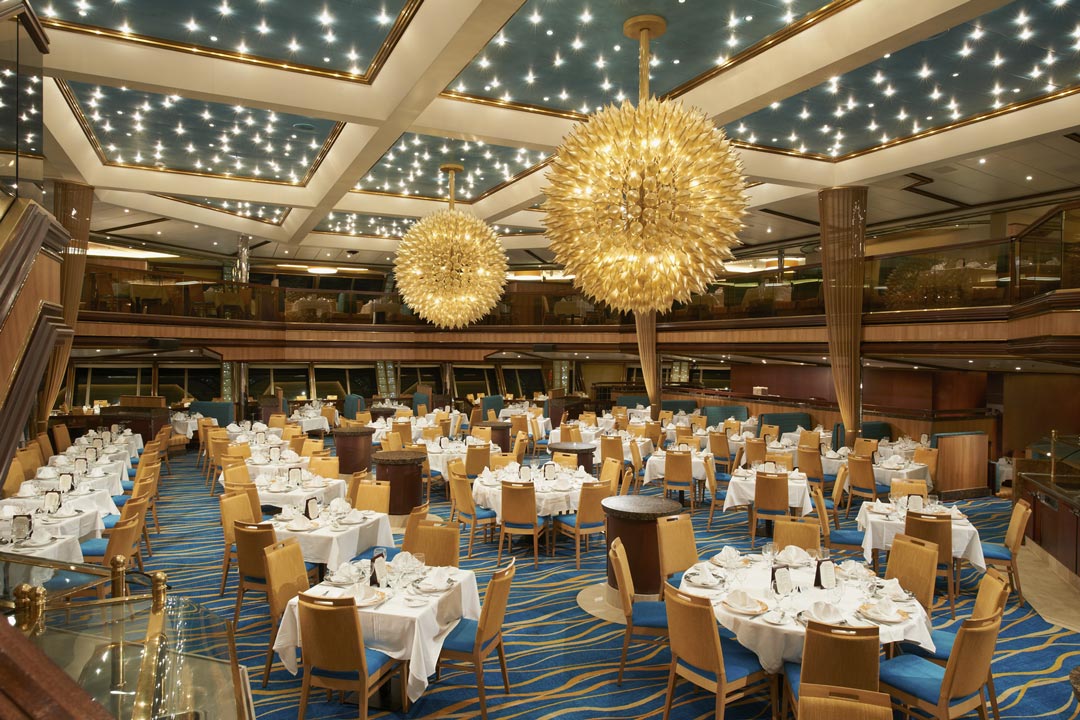
Dining and Beverages
Main Dining Room: The main dining room is the ship’s primary restaurant, typically offering a formal dining experience with multi-course meals. It is often included in the cruise fare.
Buffet: The buffet is a casual, self-serve dining option where passengers can choose from a wide variety of dishes. It’s a great option for a quick meal or for those with specific dietary preferences. The Buffet area on a Carnival ship may include The Carnival Deli, Mongolian Wok, and Bonsai Sushi Express.
Specialty Restaurants: Cruise ships often feature specialty restaurants that offer a more intimate and upscale dining experience.
These restaurants may require an additional fee or reservation. Restaurants like the Steakhouse, Sushi Bar, and Pasta Place are considered specialty restaurants.
Beverage Packages: Cruise lines offer beverage packages that allow passengers to enjoy unlimited alcoholic and non-alcoholic beverages throughout their voyage for a fixed price. These beverage packages may include a soda or bubbles package, Alcohol Package, or wine package.
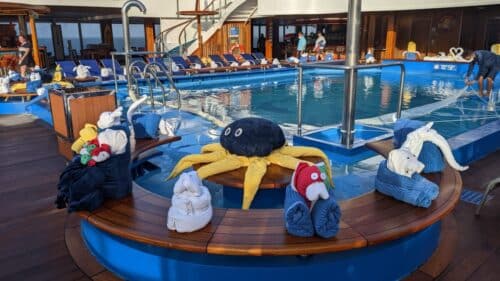
Entertainment and Activities
Daily Planner: A daily planner on a cruise (also known as a daily schedule, daily program, or day planner) is a guide to all of the activities and events that are happening on the ship on a given day. It is typically printed out and distributed to all passengers at the beginning of the day, or it can be accessed on a mobile app.
Carnival HUB app:
The Carnival HUB app is the official app of Carnival Cruise Line. It is a free app that can be downloaded and used for:
- Check-in and boarding
- Daily planner
- Dining
- Shore excursions
- Chat
- Account management
Show Lounge: The show lounge is a dedicated theater space where passengers can enjoy live performances, including Broadway-style shows, musical acts, comedians, and magic shows.
Deck Parties: Deck parties are lively events held on the ship’s outdoor decks, featuring music, dancing, and themed entertainment.
The Sail Away Party is usually the first deck party you may encounter.
Elegant Night: Elegant night on a cruise is a formal night where passengers are encouraged to dress up and enjoy a special evening. This is a great opportunity to get dressed to the nines and enjoy a delicious meal in the ship’s main dining room.
Gala Evenings: An invitation to dress in your finest black tie for a spectacular evening of music and celebration. (Cunard)
Towel Animal Theatre: Towel Animal Theater on Carnival is a live show where Carnival Cruise Line’s talented cabin stewards fold and twist towels into elaborate animal shapes and characters, and then bring them to life in a fun and entertaining performance. The show is typically held in the ship’s theater or atrium and is open to all passengers.
Towel Animal Takeover: Towel animal takeover on deck on Carnival is a special event where the ship’s cabin stewards create and place towel animals all over the Lido deck.
BINGO: Bingo is a popular activity on cruise ships. It is a fun and easy game that can be enjoyed by people of all ages. Bingo is typically played in the ship’s theater or atrium, and is open to all passengers.
Jargon about must- see events
The Chocolate Extravaganza on a Carnival cruise is a dessert buffet featuring a wide variety of chocolate desserts. The selection typically includes chocolate cakes, pies, cookies, brownies, mousse, truffles, and more. The buffet is usually held on one of the last sea days of the cruise, and it is a popular event among passengers of all ages.
Captain’s Cocktail Hour: A glamorous event where passengers mingle and indulge in delicious drinks while rubbing shoulders with the captain.
The Diamond and Platinum Party on Carnival is a special event for guests who have reached the Diamond or Platinum level of the VIFP Club. The VIFP Club is Carnival’s loyalty program, and guests earn points for every day they cruise on a Carnival ship. Once guests have earned enough points, they reach a new level of the VIFP Club, which unlocks new benefits and privileges.
Shore Excursions: Shore excursions are organized tours and activities offered at various ports of call.
Cooking Demonstration: A cooking demonstration on a cruise ship is a live event where a chef prepares a dish or dishes for the audience and explains the steps involved. Cooking demonstrations are typically held in the ship’s galley or in a dedicated cooking demonstration area.
Carnival Kitchen: Carnival Kitchen is a hands-on cooking school available on select Carnival Cruise Line ships. It offers a variety of classes for all skill levels, from beginner to experienced, taught by professional chefs. Classes cover a wide range of topics.
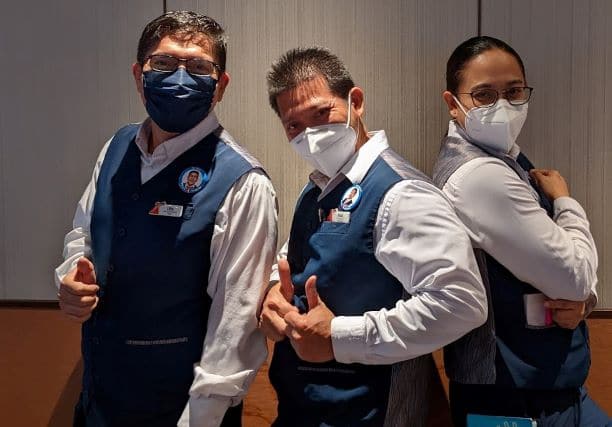
Crew and Staff
Captain: The captain is the highest-ranking officer on the ship and is responsible for the overall operation and safety of the vessel.
Cruise Director: The cruise director or CD is the onboard entertainment coordinator who oversees the ship’s daily activities, shows, and events.
Stateroom Steward: The stateroom steward or room steward is responsible for maintaining and servicing the cabins. They also create nightly Towel Animals.
Purser: A purser on a cruise ship is a staff member who is responsible for the financial matters of the ship. This includes managing passenger accounts, processing payments, and handling currency exchange. The purser is also responsible for overseeing the ship’s guest services department.
Maître d’: A maître d’ on a cruise ship is the person in charge of the restaurant. They are responsible for overseeing the dining room staff, ensuring that guests have a positive dining experience, and resolving any problems or concerns that guests may have.
Carnival Horizon sail away party
Ports of Call
Dock: A cruise ship dock is a structure in a port designed for docking to allow passengers on and off the ship, and/or for the ship to restock its provisions. Some ports have multiple piers and some piers are long enough to accommodate more than one cruise ship
Mooring a cruise ship is the process of securing the ship to a pier or dock. It is a complex and delicate operation that requires careful planning and execution.
The first step in mooring a cruise ship is to line up the ship with the pier or dock. This is done using tugboats and mooring lines. Once the ship is in position, the mooring lines are attached to bollards on the pier or dock.
The mooring lines are then tightened to secure the ship in place. The captain of the ship will use cameras and other sensors to monitor the mooring process and make sure that the ship is properly secured.
Once the ship is moored, the gangway is lowered to allow passengers to disembark. The gangway is a bridge that connects the ship to the pier or dock.
Tender: In certain ports where the ship cannot dock directly at the pier, passengers are transported to the shore via smaller boats called tenders. This small boat that takes you from cruise ship to shore may also be referred to as the Water Shuttle.
Port of Call: A port of call is a stop or destination during a cruise where the ship docks and passengers can explore a new place. Common examples of Caribbean ports of call are Cozumel, Jamaica, and St Thomas.
Port Shopping: Many cruise ports have dedicated shopping areas near the pier where passengers can find souvenirs, local handicrafts, jewelry, and duty-free items.
Crossing: A crossing on a cruise ship is a voyage that takes passengers from one port to another without making any stops in between. Crossings are typically longer than cruises that visit multiple ports, and they can last for several days or even weeks. Crossings can also be repositioning cruises.
Repositioning cruises: A repositioning cruise is a one-way cruise that takes a cruise ship from one region to another, typically to prepare for the next cruise season. Repositioning cruises can be a great way to experience longer voyages and visit exotic destinations at a lower cost than traditional cruises.
Scenic cruising is a type of cruise that focuses on the natural beauty of the destinations visited. Scenic cruises typically take passengers to remote and exotic locations, such as Alaska, Antarctica, and the Galapagos Islands. Scenic cruises often feature smaller ships with fewer passengers, which allows for a more intimate and personalized experience
In Transit Passenger: An “in transit passenger” on a back-to-back cruise is a passenger who is staying on the same ship for two or more consecutive cruises. This means that they will not be disembarking at the end of the first cruise, but will instead remain on board the ship for the duration of the second cruise.
A full transit cruise is a cruise that sails through the entire Panama Canal, from the Pacific Ocean to the Atlantic Ocean, or vice versa. Full transit cruises typically take one day to complete, and they offer passengers a unique opportunity to see this engineering marvel up close.
A partial transit cruise is a cruise that sails through a portion of the Panama Canal, typically from the Pacific Ocean to Gatun Lake, or vice versa. Partial transit cruises typically take half a day to complete, and they offer passengers a chance to see the Miraflores Locks and the Panama Canal Museum.
WHTI compliant means that a cruise ship meets the Western Hemisphere Travel Initiative (WHTI) requirements. The WHTI is a U.S. government program that requires U.S. citizens to present a valid passport or other WHTI-compliant document when entering the United States from Canada, Mexico, the Caribbean, or Bermuda.
Cruise ships that are WHTI compliant allow U.S. citizens to re-enter the United States with a valid birth certificate and government-issued photo ID, such as a driver’s license. This is because these cruise ships only travel within the Western Hemisphere and do not visit any international ports.
A closed-loop cruise is a cruise that departs and ends in the same U.S. port, and sails within the Western Hemisphere. This means that passengers on a closed-loop cruise do not need a passport to travel, as long as they are U.S. citizens.
The Jones Act also means that foreign-flagged cruise ships cannot simply sail between U.S. ports. If a foreign-flagged cruise ship wants to visit multiple U.S. ports, it must either depart from or arrive at a foreign port.
Itinerary: A cruise ship itinerary is the schedule of ports that the ship will visit on its voyage. Cruise ship itineraries vary in length, from a few days to several weeks. They also vary in terms of the types of destinations they visit. Some cruise ship itineraries focus on visiting major tourist destinations, while others focus on visiting more off-the-beaten-path locations.
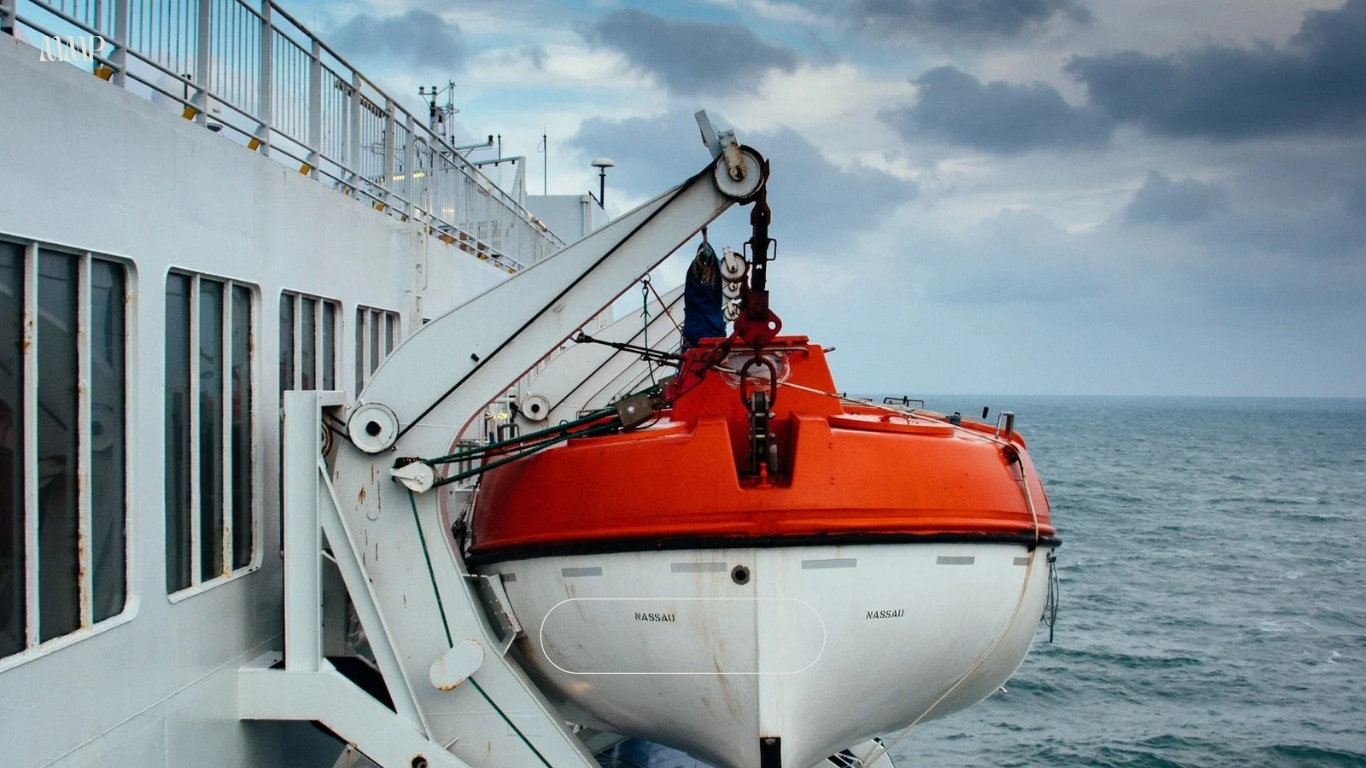
Safety and Emergency Procedures
Life Jacket: A life jacket is a personal flotation device stored in each cabin. Passengers are required to familiarize themselves with the location of their life jackets during the muster drill. You may find them in your closet, or under the bed.
Muster station or assembly station: A muster station or assembly station on a cruise ship is a designated area where passengers must report to in the event of an emergency. Muster stations are typically located on open decks, near lifeboats. Your assigned station will be listed on your cruise card.
Common codes you might here over the PA system:
Some of these codes might sound familiar. Many are the same ones used in hospitals and stores on land.
Code Red: Code Red is an emergency situation on a cruise ship related to a contagious illness outbreak.
Code Alpha: A medical emergency that may require evac by airlift.
Bravo Bravo: Bravo ( location) The code for man overboard.
Charlie, Charlie, Charlie: A security threat.
Code Adam: Code Adam is a code for a missing person or missing child on a cruise.
Code Pink: Missing or inducted infant.
Code Grey: Combative person.
Code Black: Much like a code grey. Potentially a fight, person with a weapon,or suicide threat.
Code Sierra: Medical emergency. Bring a stretcher.
Code Zulu: Fire onboard.
Brightstar ( location) or Operation Brightstar (location) The code for medical emergency or death on Carnival and Disney cruises. May also be Code Alpha.
Code Baby Ruth: Fecal matter in the pool.
Emergency Assembly Stations: Emergency assembly stations are designated locations on the ship where passengers gather in case of an emergency. These stations are indicated on the ship’s emergency evacuation plan, usually found on the back of cabin doors.
New Muster Drill Carnival Conquest
Cruise Etiquette
Formal Night: Formal nights are special evenings on a cruise where passengers can dress up in formal attire, such as elegant dresses or suits, for dinner and other events. They may also be called Elegant nights.
Respecting Quiet Hours: Cruise ships often have designated quiet hours during the night to ensure a peaceful environment for passengers in their cabins. It’s important to be mindful of noise levels during these hours.
Gratuities: Tipping is customary on most cruise lines. It’s important to familiarize yourself with the tipping policies of the cruise line you’re sailing with to ensure you provide appropriate gratuities to the staff.
Disembarkation
Port of Disembarkation: The port of disembarkation is the final destination where passengers leave the ship at the end of the cruise. It’s crucial to plan transportation arrangements from the port to your onward destination.
Customs and Immigration: Passengers are required to go through customs and immigration procedures upon disembarkation, where their passports and any necessary documentation are checked.
You might be interested in learning about Global Entry before your next cruise.
Don’t forget the Humor: funny cruise terms
A cruise journey is not only about magnificent sights and tranquil seas but also about hearty laughter and unforgettable moments.
Let’s dive into the humorous side of cruise lingo, where witty phrases and playful expressions add a splash of joy to the voyage.
“Sea”ing the Funny Side
Deck Chair Olympics: A playful competition among passengers vying for the perfect spot to sunbathe.
Chair hogs or “Chogs” are terms used to describe people who claim deck chairs or lounge chairs by placing their belongings on them and then leaving for an extended period, preventing others from using the chairs.
It’s a term commonly used on cruise ships and resorts when some guests reserve chairs but don’t actually use them, making it difficult for others to find a spot to relax by the pool or on the deck.
Shuffleboard Sharks: Experienced players who dominate the shuffleboard courts with skill and finesse.
Trivia Master or Trivia Sharks: A person on a cruise ship who goes to all the trivia activities and knows all the answers is often called a “trivia master” or a “trivia whiz”. They are the people who always seem to know the answer to every question, no matter how obscure. Trivia masters are often very knowledgeable about a wide range of topics, and they enjoy the challenge of answering difficult questions.
Midnight Buffet Mania: The frenzy that ensues when the clock strikes midnight, signaling the grand opening of a delectable buffet.
Punny Phrases to cruise by
“Current-ly” Relaxing: Embracing the blissful state of relaxation while drifting along with the ocean currents.
Ship-Shape and Sea-Fashionable: Dress up in your finest attire to impress fellow passengers and capture memorable photographs.
Bon Voyage-age: A jovial farewell phrase when bidding adieu to a fellow cruiser who is embarking on their voyage.
Conclusion:
As our nautical journey comes to a close, we hope you’ve enjoyed this deep dive into the captivating world of cruising terminology.
With your newfound knowledge of cruise terms and cruise ship words. you’ll be able to navigate the high seas with confidence, mingling effortlessly with fellow passengers and crew.
So set sail on your next cruise adventure, and remember, the journey is as much about the words spoken as the destinations reached.
Now that you’re familiar with the basics of cruise lingo, learn the essential foreign travel phrases you’ll need for your next port of call.
Smooth sailing and bon voyage!

